Proposal for a Calculation Model of Perceived Luminance in Road Tunnel Interior Environment: A Case Study of a Tunnel in China
Abstract
1. Introduction
- ●
- The luminance levels for the tunnel interior zone (the longest part of the tunnel) are extremely low (between 1 cd/m2 and 5 cd/m2) [11,12,13], falling within the mesopic vision range [14]. Spectral luminous efficiency function in the mesopic range Vmes(λ) is not constant [15,16,17], which can be expressed as a linear combination of the photopic V(λ) function and the scotopic V′(λ) function.
- ●
- ●
- The spectral property of the road targets needs to be considered. Surface color [21] refers to the spectral properties of the target surfaces, which influences the perception of luminance.
1.1. Previous Work on the Effect of SPD on Visibility in Road Tunnels
1.2. Goals and Hypothesis
2. Perception Luminance Calculation Method
2.1. Mesopic Luminance Calculation Model
2.2. New Mesopic Luminance Calculation
3. Simulation Experiments
3.1. Case Study
3.2. Simulation Software
3.3. Target Object
4. Analysis and Results
4.1. Simulation of Tunnel Model
4.2. Contrast Calculation
5. Discussion
6. Conclusions
- ●
- Lmes_new is proposed as a factor to analyze the perceived luminance after the combined effect of light source SPDs, small target reflection properties, and human visual characteristics. The results showed that the amount of reflected light or the luminance value varies depending on the surface colors. Thus, surface color may significantly influence small targets’ identification under the same light distribution environment.
- ●
- The simulation results showed that in the case of specific light distribution, the Lmes_new value of the yellow surface target is higher than that of the other three-color surface targets. In contrast, the blue surface target has the lowest Lmes_new value.
- ●
- In the case of the yellow/red color surface target, the Lmes_new value under a low CCT LED is higher than that under a high CCT LED. On the contrary, for the blue/green color surface target, the Lmes_new value under a low CCT LED is smaller than that under a high CCT LED.
- ●
- The main limitation is that the work is a simulation-based study. Future studies should be conducted in an actual tunnel to confirm the results. Future studies should also consider the effects of vehicle headlamps with different SPDs. In other words, additional research is needed to distinguish between novice and experienced drivers, male and female drivers, and younger and older drivers.
Author Contributions
Funding
Institutional Review Board Statement
Informed Consent Statement
Data Availability Statement
Conflicts of Interest
References
- Tsai, M.-S.; Lee, X.-H.; Lo, Y.-C.; Sun, C.-C. Optical design of tunnel lighting with white light-emitting diodes. Appl. Opt. 2014, 53, H114. [Google Scholar] [CrossRef]
- Makarov, V.V. Island megalopolises: Tunnel systems as a critical alternative in solving transport problems. Eng. Cybersecur. 2018, 4, 138–142. [Google Scholar] [CrossRef]
- Qin, L.; Shi, X.; Leon, A.S.; Tong, C.; Ding, C. Dynamic luminance tuning method for tunnel lighting based on data mining of real-time traffic flow. Build. Environ. 2020, 176, 106844. [Google Scholar] [CrossRef]
- Transportation Department. Statistical bulletin on the development of the transportation industry in 2020. Financ. Account. Commun. 2021, 6, 92–97. [Google Scholar]
- Peña-García, A.; Gómez-Lorente, D. Installation of solar panels in the surroundings of tunnel portals: A double-targeted strategy to decrease lighting requirements and consumption. Tunn. Undergr. Space Technol. 2020, 97, 103251. [Google Scholar] [CrossRef]
- Zhang, Y.; Zhuo, X.; Guo, W.; Wang, X.; Zhao, Z. Lighting environment optimization of highway tunnel entrance based on simulation research. Int. J. Environ. Res. Public Health 2019, 16, 2195. [Google Scholar] [CrossRef]
- Salata, F.; Golasi, I.; Bovenzi, S.; Vollaro, E.; Pagliaro, F.; Cellucci, L.; Coppi, M.; Gugliermetti, F.; Vollaro, A. Energy optimization of road tunnel lighting systems. Sustainability 2015, 7, 9664–9680. [Google Scholar] [CrossRef]
- Peña-García, A. Sustainable tunnel lighting: One decade of proposals, advances and open points. Tunn. Undergr. Space Technol. 2022, 119, 104227. [Google Scholar] [CrossRef]
- Jang, D.; Yook, S.-J.; Lee, K.-S. Optimum design of a radial heat sink with a fin-height profile for high-power LED lighting applications. Appl. Energy 2014, 116, 260–268. [Google Scholar] [CrossRef]
- 1Zeng, H.; Qiu, J.; Shen, X.; Dai, G.; Liu, P.; Le, S. Fuzzy control of led tunnel lighting and energy conservation. Tsinghua Sci. Technol. 2011, 16, 576–582. [Google Scholar]
- CIE 88:2004; Guide for the Lighting of Road Tunnels and Underpasses. CIE: Vienna, Austria, 2004.
- CETU. In Dossier Pilote des Tunnels-Eclairage; SPECIFIQUE J.L.P: Lyon, France, 2000.
- FD CEN/CR 14380; Lighting Applications-Tunnel Lighting. Association Francaise de Normalisation: Paris, France, 2006.
- Yao, Q.; Yuan, L.; Bian, Y. Establishment of vision effect diagram for optimization of smart led lighting. IEEE Photonics J. 2016, 8, 1–8. [Google Scholar] [CrossRef]
- He, Y.; Rea, M.; Bierman, A.; Bullough, J. Evaluating Light Source Efficacy under Mesopic Conditions Using Reaction Times. J. Illum. Eng. Soc. 1997, 26, 125–138. [Google Scholar] [CrossRef]
- He, Y.; Bierman, A.; Rea, M. A system of mesopic photometry. Light. Res. Technol. 1998, 30, 175–181. [Google Scholar] [CrossRef]
- Viikari, M.; Chen, W.; Eloholma, M.; Halonen, L.; Chen, D. Comparative study of two visual performance based mesopic models based on reaction time and contrast threshold data. Light Eng. 2006, 14, 13. [Google Scholar]
- Beckwith, D.; Zhang, X.; Smalley, E.; Chan, L.; Yand, M. LED streetlight application assessment project: Pilot study in Seattle, Washington. Transp. Res. Rec. 2011, 2250, 65–75. [Google Scholar] [CrossRef]
- Petrulis, A.; Petkevičius, L.; Vitta, P.; Vaicekauskas, R.; Žukauskas, A. Exploring Preferred Correlated Color Temperature in Outdoor Environments Using a Smart Solid-State Light Engine. LEUKOS 2018, 14, 95–106. [Google Scholar] [CrossRef]
- Davidovic, M.; Djokic, L.; Cabarkapa, A.; Kostic, M. Warm white versus neutral white LED street lighting: Pedestrians' impressions. Light. Res. Technol. 2019, 51, 1237–1248. [Google Scholar] [CrossRef]
- Zak, P.; Zalesak, J. The influence of spectral properties of light in street lighting on visual perception. In Proceedings of the 2016 IEEE Lighting Conference of the Visegrad Countries (Lumen V4), Karpacz, Poland, 13–16 September 2016; pp. 1–4. [Google Scholar]
- Dong, L.; Zhao, E.; Chen, Y.; Qin, G.; Xu, W. Impact of led color temperatures on perception luminance in the interior zone of a tunnel considering fog transmittance. Adv. Civ. Eng. 2020, 2020, 1–13. [Google Scholar] [CrossRef]
- Fotios, S.; Cheal, C.; Boyce, P. Light source spectrum, brightness perception and visual performance in pedestrian environments: A review. Light. Res. Technol. 2005, 37, 271–291. [Google Scholar] [CrossRef]
- Preciado, O.; Manzano, E. Spectral characteristics of road surfaces and eye transmittance: Effects on energy efficiency of road lighting at mesopic levels. Light. Res. Technol. 2018, 50, 842–861. [Google Scholar] [CrossRef]
- Akashi, Y.; Rea, M.S.; Bullough, J.D. Driver decision making in response to peripheral moving targets under mesopic light levels. Light. Res. Technol. 2007, 39, 53–67. [Google Scholar] [CrossRef]
- Gibbons, R.; Terry, T.; Bhagavathula, R.; Meyer, J.; Lewis, A. Applicability of mesopic factors to the driving task. Light. Res. Technol. 2016, 48, 70–82. [Google Scholar] [CrossRef]
- Gibbons, R.; Meyer, J.; Terry, T.; Bhagavathula, R.; Lewis, A.; Flanagan, M.; Connell, C. Evaluation of the Impact of Spectral Power Distribution on Driver Performance; Technical Report FHWA-HRT-15-047; Turner-Fairbank Highway Research Center: McLean, Virginia, 2015. [Google Scholar]
- Jin, H.; Jin, S.; Chen, L.; Cen, S.; Yuan, K. Research on the lighting performance of led street lights with different color temperatures. IEEE Photonics J. 2015, 7, 1–9. [Google Scholar] [CrossRef]
- Jin, P.; Wang, Y.; Zhou, Q.; Rooymans, J.; Yu, C. Luminous efficacy of white LED in the mesopic vision state. Optoelectron. Lett. 2009, 5, 265–267. [Google Scholar] [CrossRef]
- Bandopadhyay, S.; Kole, A. Review and studies on the effect of spectral composition of LED based lighting system over its scotopic-photopic ratio. In Proceedings of the 2016 International Conference on Intelligent Control Power and Instrumentation (ICICPI), Kolkata, India, 21–23 October 2016; p. 5. [Google Scholar]
- Yang, Y.; Han, W.Y.; Yan, M.; Jiang, H.F.; Zhu, L.W. The performance analysis for lighting sources in highway tunnel based on visual function. Guang Pu Xue Yu Guang Pu Fen Xi 2015, 35, 2686–2690. [Google Scholar] [PubMed]
- Liu, Y.; Peng, L.; Lin, L.; Chen, Z.; Weng, J.; Zhang, Q. The impact of LED spectrum and correlated color temperature on driving safety in long tunnel lighting. Tunn. Undergr. Space Technol. 2021, 112, 103867. [Google Scholar] [CrossRef]
- Liang, B.; He, S.; Tähkämö, L.; Tetri, E.; Cui, L.; Dangol, R.; Halonen, L. Lighting for road tunnels: The influence of CCT of light sources on reaction time. Displays 2020, 61, 101931. [Google Scholar] [CrossRef]
- Dong, L.; Qin, L.; Xu, W.; Zhang, L. The impact of led correlated color temperature on visual performance under mesopic conditions. IEEE Photonics J. 2017, 9, 1–16. [Google Scholar] [CrossRef]
- Zhang, X.; Hu, J.; Wang, R.; Gao, X.; He, L. The comprehensive efficiency analysis of tunnel lighting based on visual performance. Adv. Mech. Eng. 2017, 9, 168781401769644. [Google Scholar] [CrossRef]
- Boyce, P.R.; Eklund, N.H.; Hamilton, B.J.; Bruno, L.D. Perceptions of safety at night in different lighting conditions. Light. Res. Technol. 2000, 32, 79–91. [Google Scholar] [CrossRef]
- CIE 191:2010; Recommended System for Mesopic Photometry Based on Visual Performance. CIE Publication: Vienna, Austria, 2010.
- Ohno, Y. Practical use and calculation of CCT and Duv. LEUKOS 2014, 10, 47–55. [Google Scholar] [CrossRef]
- Durmus, D. Correlated color temperature: Use and limitations. Light. Res. Technol. 2022, 54, 363–375. [Google Scholar] [CrossRef]
- Maksimainen, M.; Kurkela, M.; Bhusal, P.; Hyyppä, H. Calculation of mesopic luminance using per pixel s/p ratios measured with digital imaging. LEUKOS 2019, 15, 309–317. [Google Scholar] [CrossRef]
- JTG/T D70/2-01-2014; Guidelines for Design of Highway Tunnels. China Communications Press: Beijing, China, 2014.
- CEN EN 13201-3:2003; Calculation of Performance. German Version DIN: Berlin, Germany, 2003.
- Jiaming, D.; Hongyan, M. Analysis and optimization of ancient building lighting based on DIALux. In Proceedings of the 2020 Chinese Control and Decision Conference (CCDC), Hefei, China, 22–24 August 2020; pp. 134–139. [Google Scholar]
- Lim, G.-H.; Keumala, N.; Ghafar, N.A. Energy saving potential and visual comfort of task light usage for offices in Malaysia. Energy Build. 2017, 147, 166–175. [Google Scholar] [CrossRef]
- Salvadori, G.; Fantozzi, F.; Rocca, M.; Leccese, F. The energy audit activity focused on the lighting systems in historical buildings. Energies 2016, 9, 998. [Google Scholar] [CrossRef]
- American National Standards Institute/Illuminating Engineering Society of North America. Recommended Practice for Design and Maintenance of Roadway and Parking Facility Lighting; DRAFT RP-22-05; IES: New York, NY, USA, 2018; 475p. [Google Scholar]
- Narisada, K.; Yoshikawa, K. Lighting of short tunnels- effects of exit luminance on the lighting level. J. Illum. Eng. Inst. Jpn. 1978, 62, 11–18. [Google Scholar]
- Abbadi, N.K.E.; Razaq, E.S. Automatic gray images colorization based on lab color space. Indones. J. Electr. Eng. Comput. Sci. 2020, 18, 1501–1509. [Google Scholar] [CrossRef]
- Xu, H.-S. Color Information Engineering, 2nd ed.; Zhejiang University Press: Hangzhou, China, 2015. [Google Scholar]
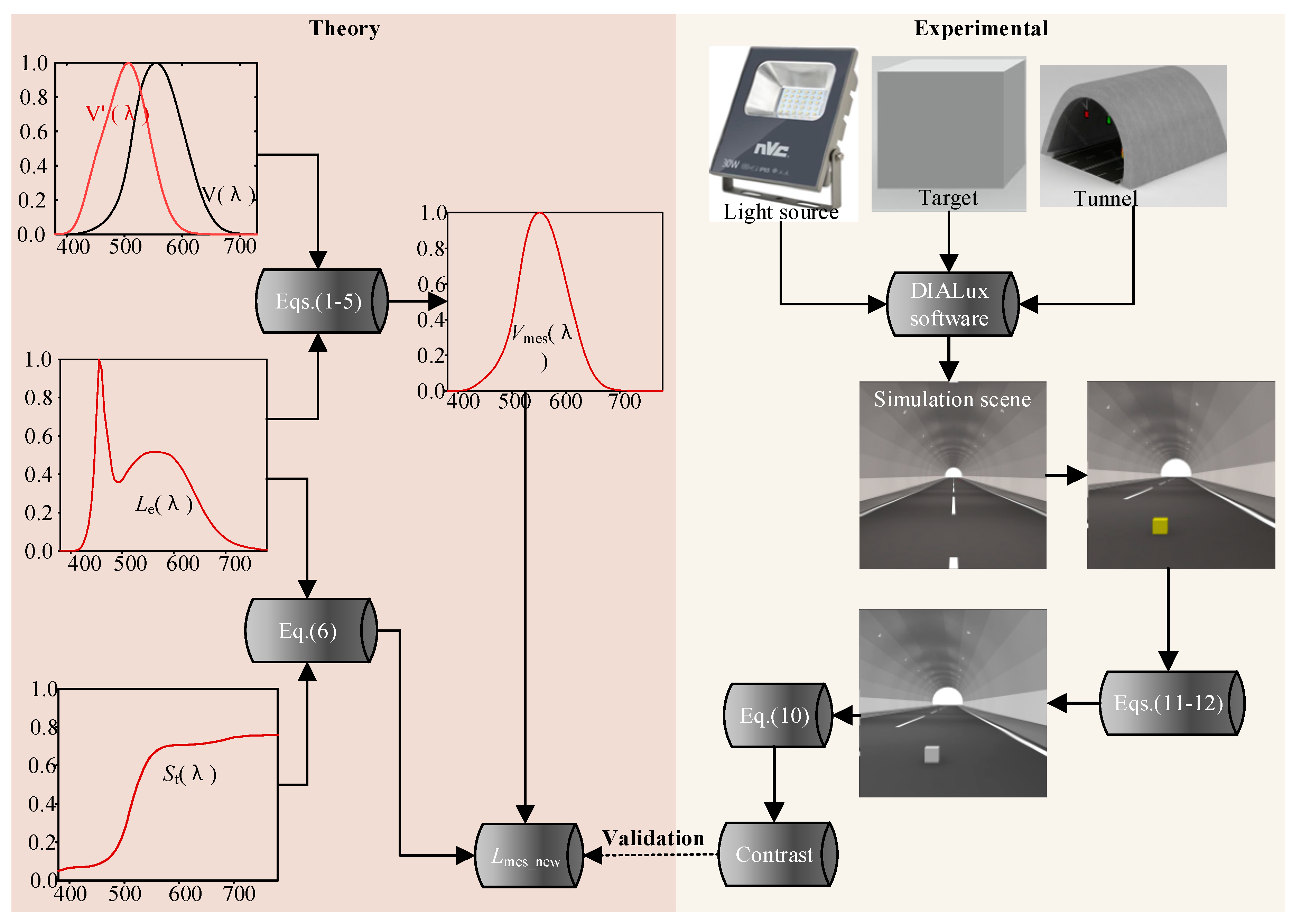
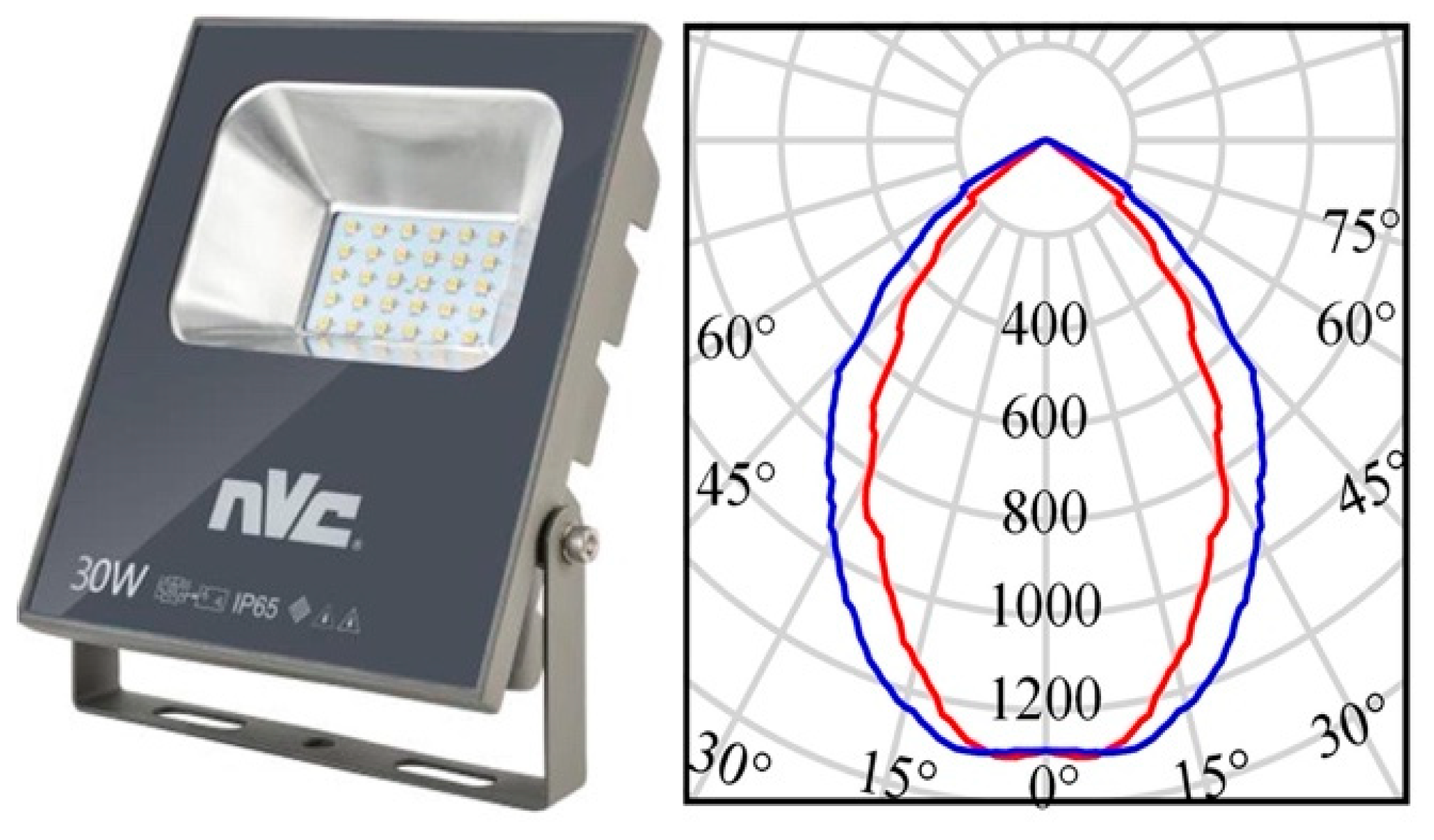
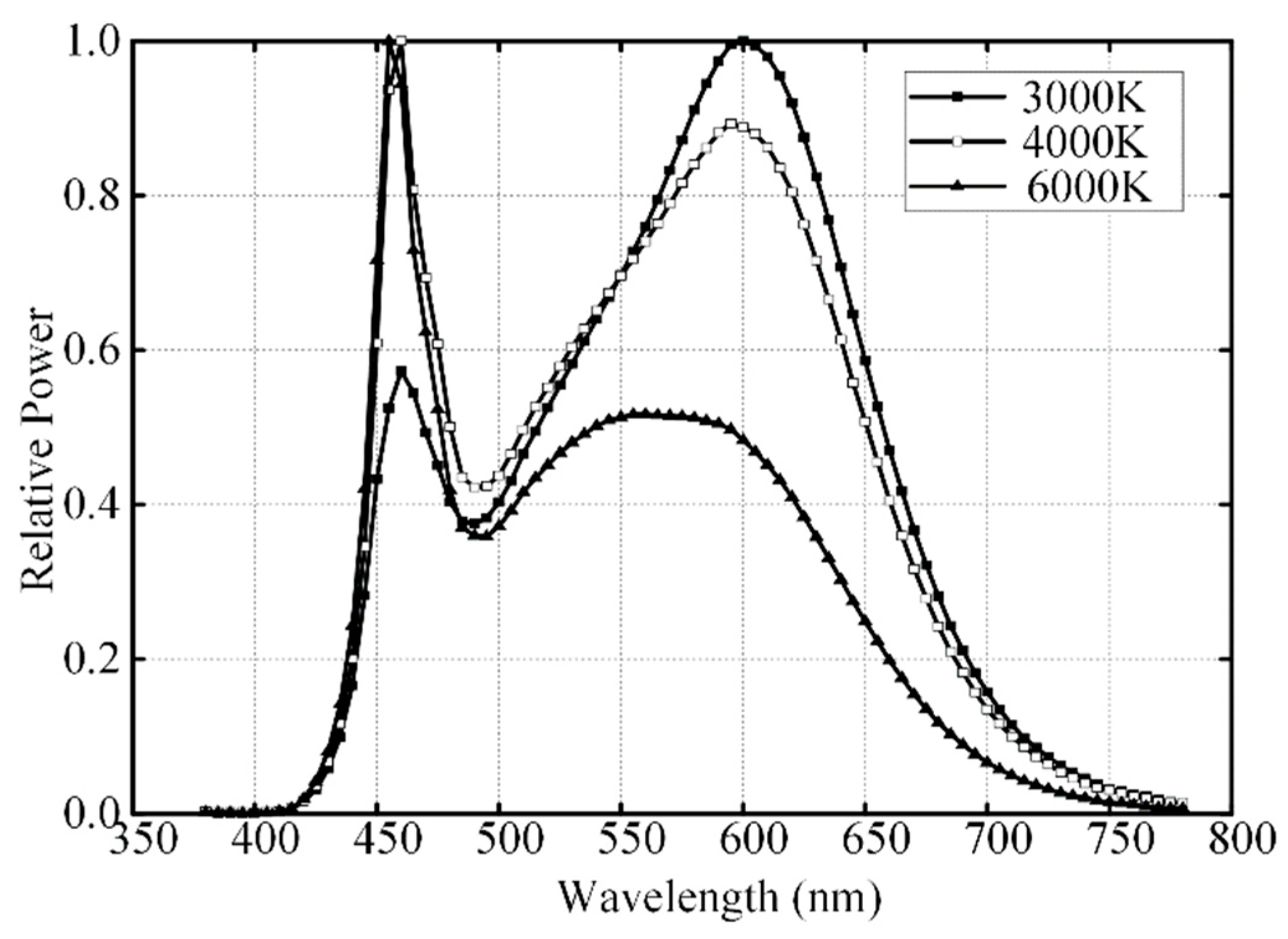





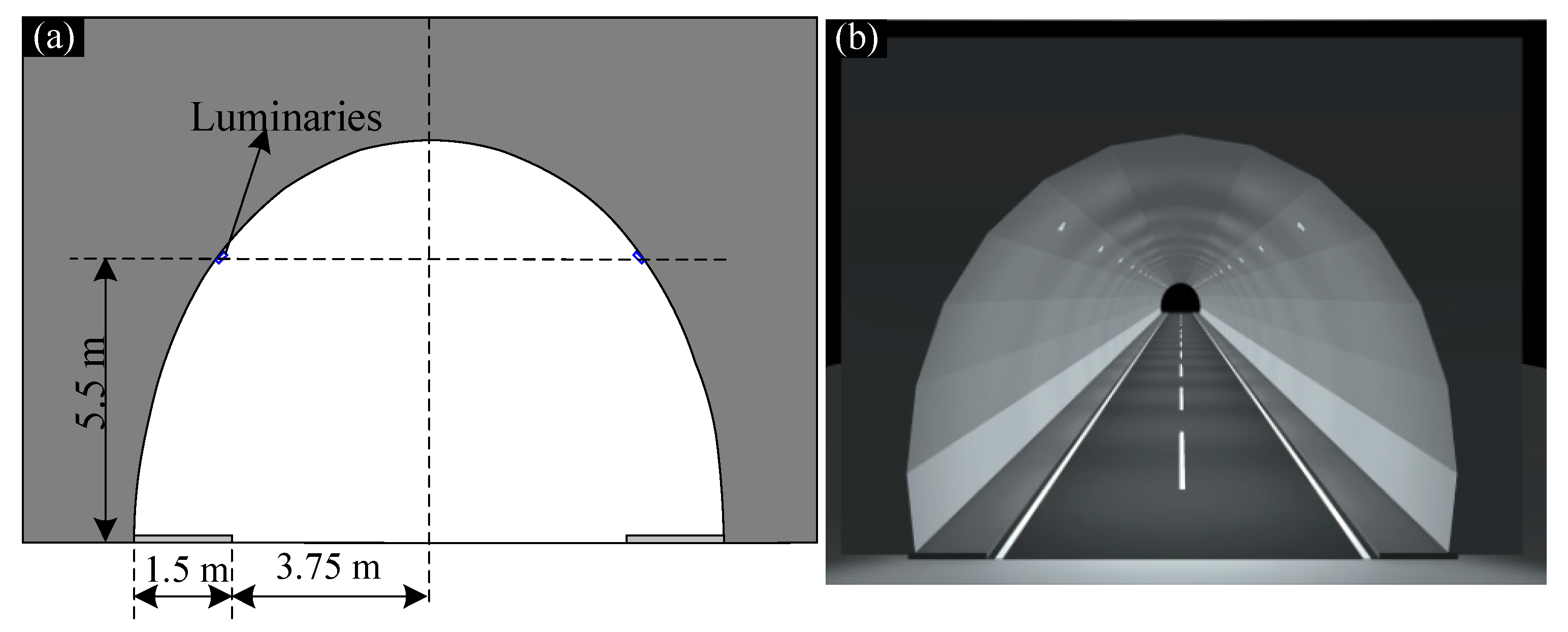
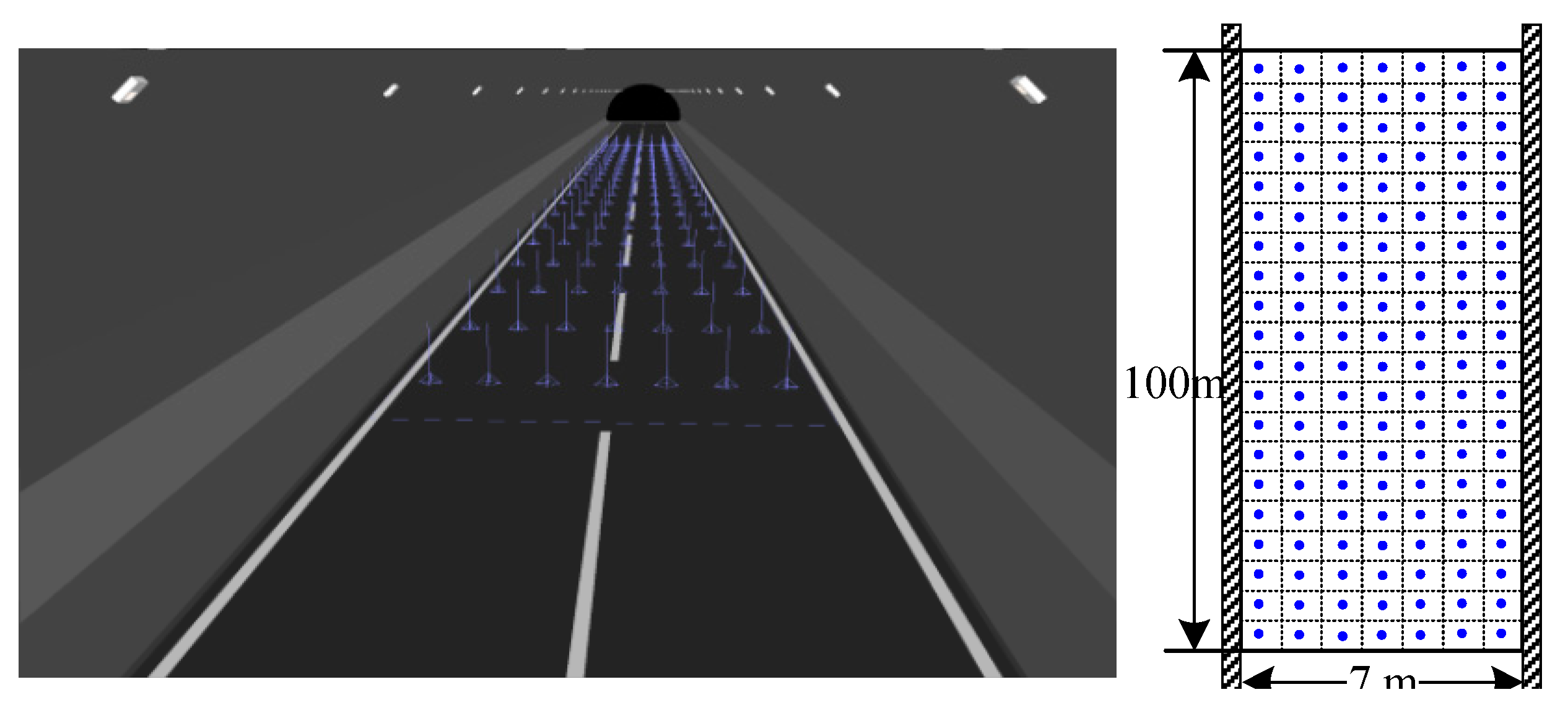


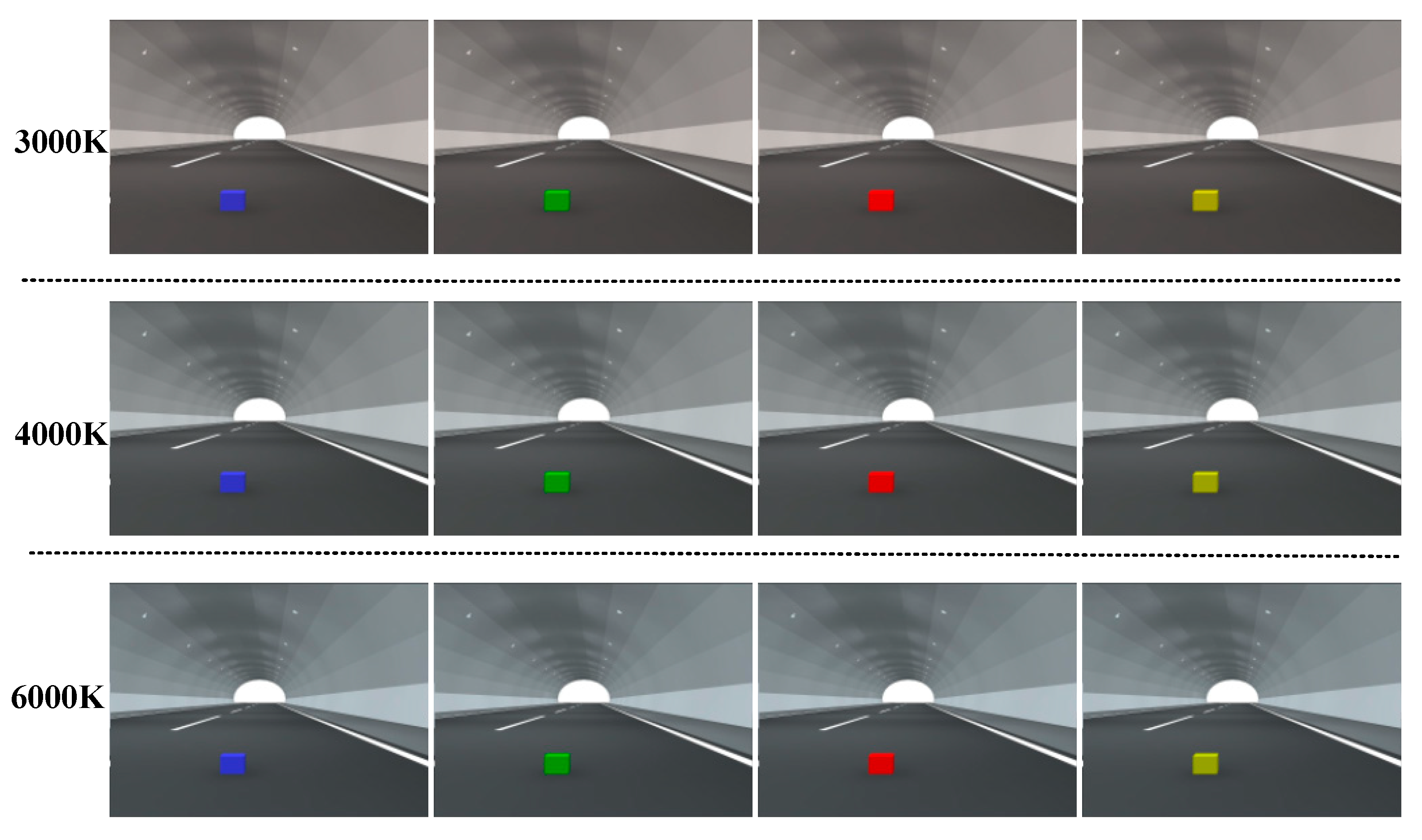

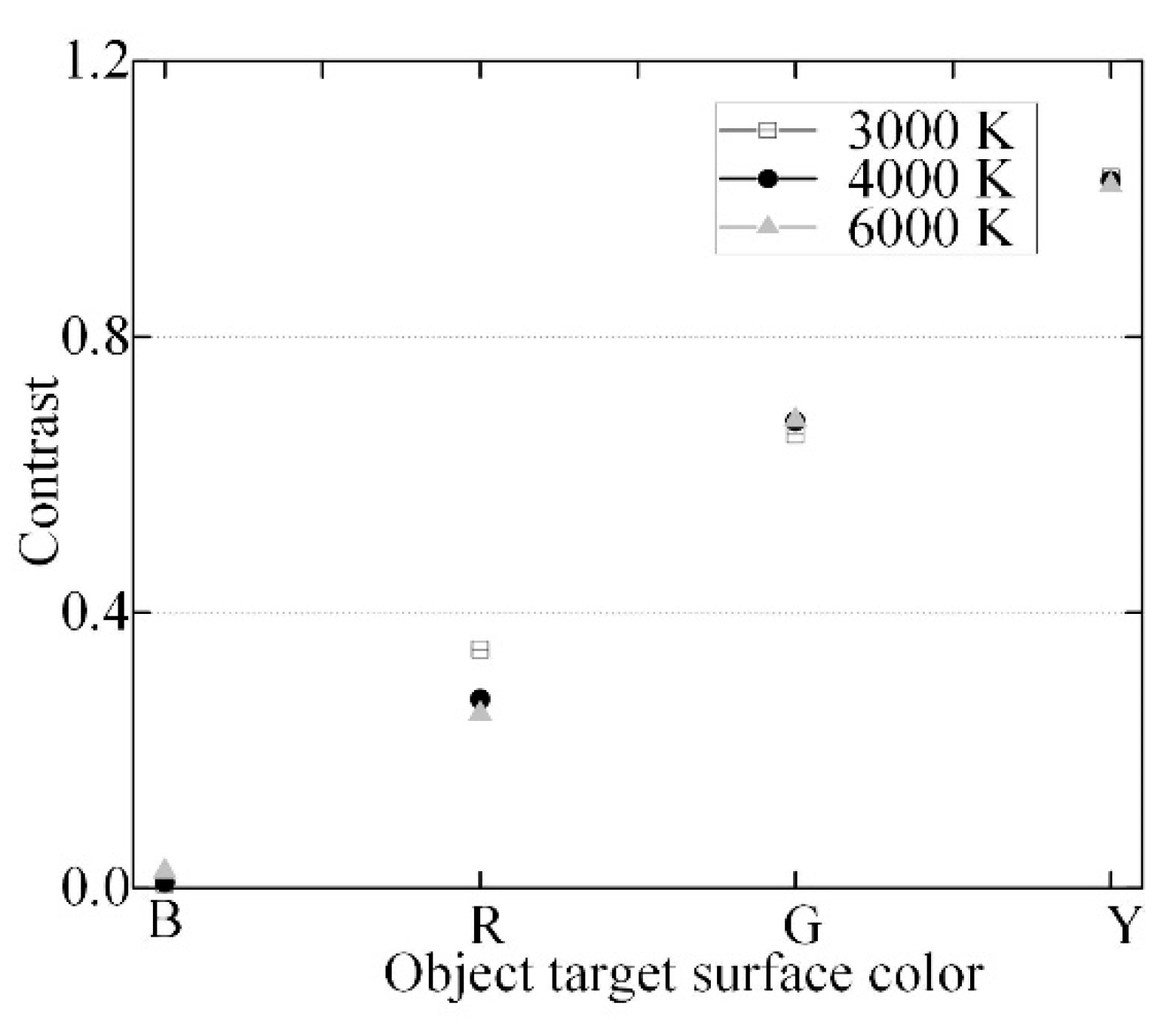
| No. | 1 | 2 | 3 |
|---|---|---|---|
| Luminous | 2100 lm | 2100 lm | 2100 lm |
| Electric power | 30 W | 30 W | 30 W |
| CCT | 3000 K | 4000 K | 6000 K |
| Duv | −0.0006 | −0.0012 | 0.0044 |
| Parameter | Value |
|---|---|
| L | 1140 m |
| Ds | 100 m |
| h | 6 m |
| Vt | 80 km/h |
| N | 704 Veh/(h۰ln) |
| Din | 826 m |
| Lin | 2.5 cd/m2 |
| Target Surface Color | B | G | R | Y | |
|---|---|---|---|---|---|
| LED CCT | |||||
| 3000 K | 0.0064 | 0.6579 | 0.3467 | 1.0309 | |
| 4000 K | 0.0080 | 0.6773 | 0.2744 | 1.0265 | |
| 6000 K | 0.0246 | 0.6791 | 0.2529 | 1.0196 | |
Publisher’s Note: MDPI stays neutral with regard to jurisdictional claims in published maps and institutional affiliations. |
© 2022 by the authors. Licensee MDPI, Basel, Switzerland. This article is an open access article distributed under the terms and conditions of the Creative Commons Attribution (CC BY) license (https://creativecommons.org/licenses/by/4.0/).
Share and Cite
Qin, L.; He, S.; Yang, D.; Leon, A.S. Proposal for a Calculation Model of Perceived Luminance in Road Tunnel Interior Environment: A Case Study of a Tunnel in China. Photonics 2022, 9, 870. https://doi.org/10.3390/photonics9110870
Qin L, He S, Yang D, Leon AS. Proposal for a Calculation Model of Perceived Luminance in Road Tunnel Interior Environment: A Case Study of a Tunnel in China. Photonics. 2022; 9(11):870. https://doi.org/10.3390/photonics9110870
Chicago/Turabian StyleQin, Li, Shiyong He, Deshan Yang, and Arturo S. Leon. 2022. "Proposal for a Calculation Model of Perceived Luminance in Road Tunnel Interior Environment: A Case Study of a Tunnel in China" Photonics 9, no. 11: 870. https://doi.org/10.3390/photonics9110870
APA StyleQin, L., He, S., Yang, D., & Leon, A. S. (2022). Proposal for a Calculation Model of Perceived Luminance in Road Tunnel Interior Environment: A Case Study of a Tunnel in China. Photonics, 9(11), 870. https://doi.org/10.3390/photonics9110870







